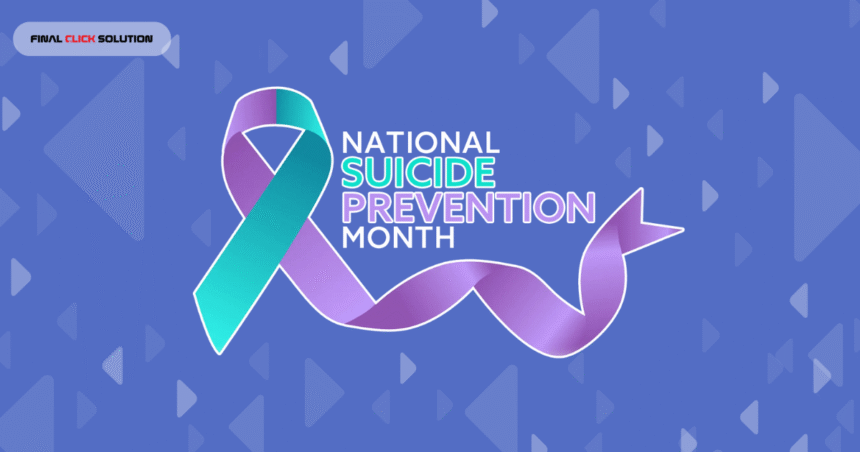Every year in September, communities across the United States observe National Suicide Prevention Month, a dedicated time to raise awareness, promote mental health education, and remind individuals that support, hope, and help are always available. In 2024–2025, suicide prevention continues to be a critical national priority, as mental health concerns rise and more communities seek reliable information, early intervention strategies, and compassionate resources.
This awareness month encourages open conversations that reduce stigma, empower individuals to speak up, and connect people with lifesaving support. Suicide is a difficult topic, often surrounded by silence or misunderstanding, but breaking that silence saves lives. When families, friends, and communities understand the risks, warning signs, and avenues for help, they are better equipped to guide someone toward safety.
Suicide in 2024–2025: Understanding the Current Landscape
As of 2024, the United States continues to experience high suicide rates that concern mental health professionals, public health advocates, and community leaders alike. According to the CDC, nearly 50,000 Americans died by suicide in 2023, marking one of the highest numbers ever recorded. Early data projections suggest that rates in 2024 may remain similarly elevated, especially within populations facing economic hardship, limited access to mental health resources, or increased stress.
These numbers highlight a sobering reality:
Suicide remains one of the leading causes of death across many age groups, including teens, young adults, and middle-aged individuals.
Yet, experts emphasize one key message:
Many suicides are preventable with the right support, timely intervention, and stronger public awareness.
That is exactly why National Suicide Prevention Month plays such an important role each year.
Why National Suicide Prevention Month Matters
1. It Raises Public Awareness
Many people still do not fully understand the complexity of suicide. This month encourages open discussions, informative campaigns, and community events to educate the public on mental health, risk factors, and prevention strategies.
2. It Reduces Stigma
Despite growing awareness, stigma remains one of the biggest barriers to seeking mental health help. People may fear being judged, misunderstood, or seen as weak. National Suicide Prevention Month challenges these misconceptions and promotes understanding and compassion.
3. It Encourages People to Seek Help Early
When individuals feel safe discussing their struggles, they are more likely to reach out. Early intervention can significantly reduce suicide risk and improve long-term mental health outcomes.
4. It Highlights Resources and Support Systems
From crisis hotlines to community mental health programs, this month helps circulate knowledge of readily available resources.
Recognizing the Warning Signs of Suicide
Suicide often has warning signs, though they can be subtle or mistaken for typical stress or mood changes. Recognizing these signs early can make a life-saving difference.
Common Emotional and Verbal Warning Signs
- Talking about wanting to die, being a burden, or expressing feelings of hopelessness
- Saying things like “I can’t go on,” “It doesn’t matter,” or “Everyone would be better off without me”
- Expressing deep emotional pain, sadness, or emptiness
Behavioral Warning Signs
- Withdrawing from friends, family, or activities once enjoyed
- Sudden changes in mood, such as extreme sadness followed by calmness
- Increased use of drugs or alcohol
- Reckless behavior or self-harm tendencies
- Giving away prized possessions
- Searching online for ways to die
- Loss of interest in personal care or responsibilities
Situational Warning Signs
- Recent trauma or life crisis
- Financial stress, unemployment, or housing instability
- Relationship problems or significant loss
- Chronic pain or health challenges
It is important to remember:
Not everyone shows the same signs, and not all signs indicate immediate danger. But any of these should prompt conversation and support.
How to Help Someone Who May Be Struggling
Many people worry that asking someone about suicide will somehow “put the idea in their head.” This is a myth. Mental health professionals repeatedly affirm that asking directly is not harmful—it is life-saving.
Below are effective steps for approaching and supporting someone who may be at risk.
1. Start the Conversation Compassionately
Use gentle, nonjudgmental language. You might say:
- “I’ve noticed you haven’t seemed like yourself lately. How are you feeling?”
- “I care about you, and I want to check in. Are you thinking about hurting yourself?”
2. Listen Without Interrupting
Let them express their feelings openly. Avoid minimizing statements such as:
- “It’s not that bad.”
- “You just need to be positive.”
What they need is validation and understanding.
3. Encourage Professional Help
Suggest talking to a counselor, therapist, or doctor. Offer to help them find local resources or accompany them to an appointment if they’re open to it.
4. Stay With the Person if They Are in Immediate Danger
Never leave someone alone if they indicate they may harm themselves. Contact emergency services or a crisis hotline right away.
5. Know the Lifeline Number: 988
The 988 Suicide & Crisis Lifeline is available nationwide in the U.S. and operates 24/7.
Individuals can call, text, or chat with trained crisis counselors at any time.
6. Follow Up Later
Ongoing support matters. A simple message or check-in call can remind someone they are valued and not alone.
National Suicide Prevention Month 2024–25: Key Focus Areas
The 2024–25 awareness initiatives emphasize several important themes shaping the national conversation on suicide prevention:
1. Expanding Mental Health Access
With the rising need for mental health support, communities are working to increase access to affordable therapy, crisis services, telehealth options, and counseling programs.
2. Educating Youth and Parents
Young people face increasing pressures—academic stress, social media comparison, bullying, identity challenges, and more. Awareness campaigns aim to educate families on how to support teens and young adults effectively.
3. Supporting High-Risk Groups
Certain populations statistically face higher suicide risks, including:
- Veterans
- LGBTQ+ youth
- Native American communities
- Middle-aged men
- Individuals facing economic instability
- People living with chronic mental or physical illness
By understanding these vulnerabilities, communities can offer targeted support and culturally informed outreach.
4. Promoting Workplace Mental Health
More companies are now offering employee mental health programs, mental health days, access to counseling, and wellness resources.
5. Encouraging Post-Crisis Support
Individuals recently discharged from hospitals or crisis centers benefit greatly from ongoing monitoring, therapy, and structured support.
The Role of Community in Suicide Prevention
Suicide prevention is not the responsibility of medical providers alone—it is a collective effort. Families, friends, coworkers, neighbors, teachers, and community leaders all play crucial roles.
How Communities Can Contribute
- Hosting educational workshops
- Sharing information about 988
- Creating safe spaces for conversation
- Supporting local mental health organizations
- Promoting mental health days and community wellness events
- Encouraging compassion, not judgment
When communities shift their culture toward openness and empathy, lives are saved.
The Importance of Mental Health Conversations in 2024–25
The conversation around mental health has become more normalized in recent years, yet stigma still prevents many from seeking help. National Suicide Prevention Month encourages people to talk about:
- Depression
- Anxiety
- Trauma
- Stress
- Grief
- Loneliness
- Emotional exhaustion
These conversations help break down walls and give people permission to seek help without shame.
988: The Lifeline Everyone Should Know
In 2022, the U.S. introduced 988 as the new, easy-to-remember Suicide & Crisis Lifeline number. In 2024–25, this number continues to serve millions of callers, providing immediate support for:
- Thoughts of suicide
- Mental health crises
- Substance use concerns
- Emotional distress
- Support for worried friends and family
Text, call, or chat—available 24/7.
Knowing this number saves lives, and sharing it amplifies the impact.
Practical Ways You Can Support Suicide Prevention
Here are meaningful actions anyone can take this year:
1. Learn the Warning Signs
Education empowers timely interventions.
2. Talk About Mental Health Openly
Normalize conversations around stress, anxiety, and feelings of hopelessness.
3. Share Crisis Resources on Social Media
One post can reach someone silently struggling.
4. Participate in Community Events
Many cities host walks, mental health fairs, or remembrance events in September.
5. Check in on Loved Ones Regularly
Sometimes the most private individuals are struggling the most.
6. Encourage Therapy Without Judgment
Seeking help is a sign of strength, not weakness.
7. Reduce Access to Lethal Means
Safe storage of medications, firearms, or harmful substances can significantly reduce suicide risks.
Moving Forward Together: Hope, Healing, and Prevention
National Suicide Prevention Month serves as a reminder that everyone deserves compassion, connection, and understanding. No one should feel they must face emotional pain alone. When communities embrace open dialogue, reduce stigma, and offer support, they create environments that nurture healing and resilience.






